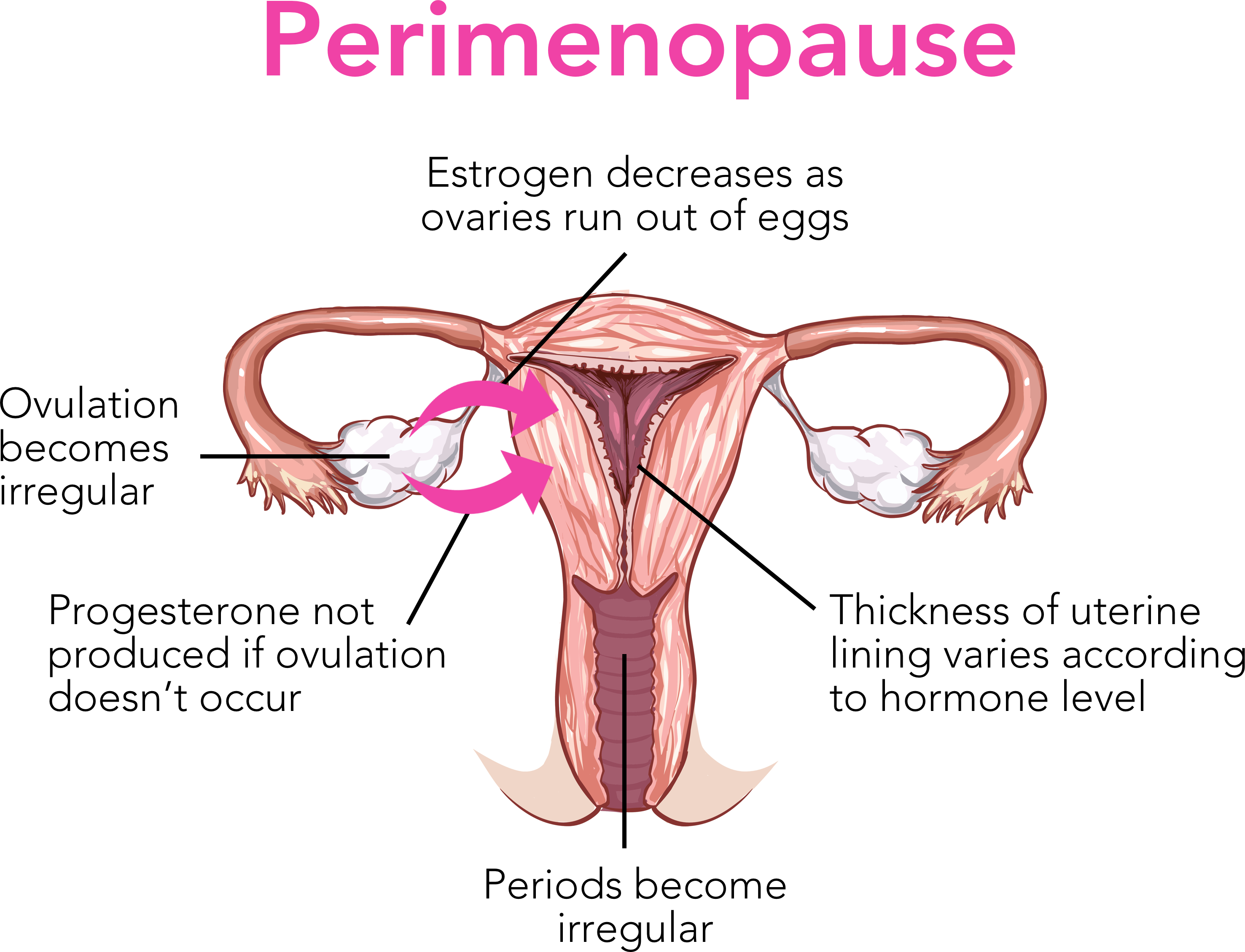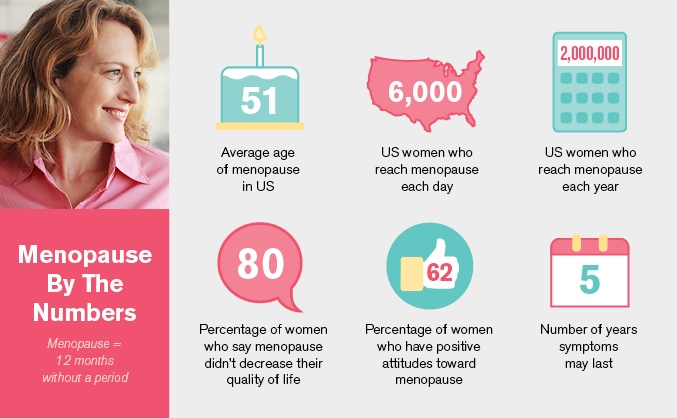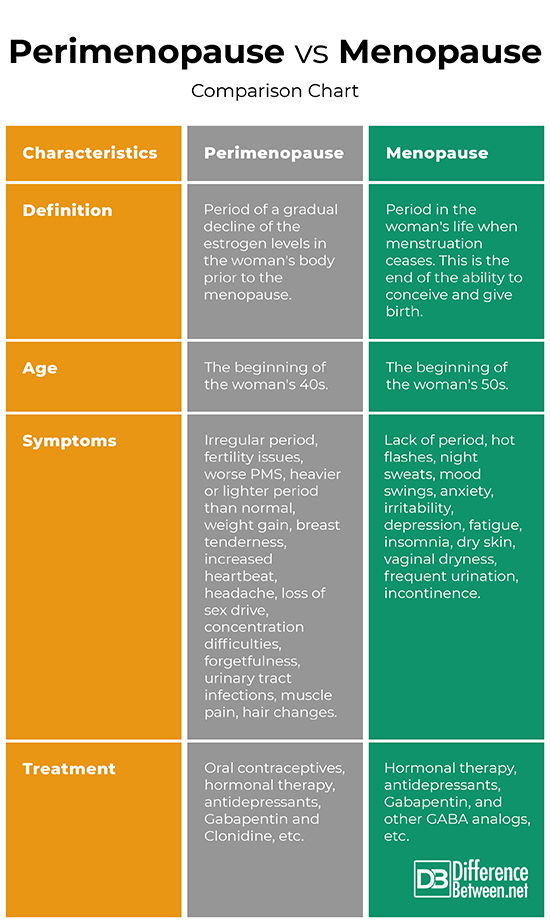Difference Between Perimenopause and Menopause
What is Perimenopause?
Perimenopause is a period of gradual decline of the estrogen levels in the woman’s body. Perimenopause is a transitional stage. It is a normal physiological stage occurring prior to the menopause.
Perimenopause begins at a different age, usually at the beginning of the woman’s 40s. However, it may start earlier or later. It is considered ended when the woman hasn’t had a menstruation for 12 consecutive months.
Perimenopause may last from few months to 8-10 years. Typically, its duration is about 4 years.

Symptoms of perimenopause include:
- Irregular period;
- Fertility issues;
- Worse PMS than normal;
- Heavier or lighter period than normal;
- Weight gain;
- Breast tenderness;
- Increased heartbeat;
- Headache;
- Loss of sex drive;
- Concentration difficulties, forgetfulness;
- Urinary tract infections;
- Muscle pain;
- Hair changes.
As estrogen levels decrease, women may start experiencing some of the symptoms of menopause.
The perimenopause is diagnosed based on the age, symptoms, and analysis of the hormones’ levels in the blood. During the perimenopause period, however, the levels of the hormones often vary. For maximum accuracy, it is necessary to make a few tests at different times.
Some lifestyle changes can reduce the severity of the perimenopause symptoms. These are limiting smoking and alcohol, increased physical activity, etc.
Treatment can help deal with some symptoms and, if necessary or if an early perimenopause occurs, treatment may be aimed at protecting the body from bone loss and osteoporosis. Treatment may include:
- Oral contraceptives to reduce symptoms and regulate the period;
- Hormonal therapy;
- Antidepressants and other medicines such as Gabapentin and Clonidine, which can help with mood changes;
- Calcium and vitamin D to protect bone loss and early osteoporosis.

What is Menopause?
Menopause is a period in the woman’s life when the menstruation ceases. This is the end of the ability to conceive and give birth. It is considered that the menopause has started when no menstruation is reported for one year.
The menopause is not a disease, it is part of the natural aging process.
The average age of onset of menopause is at the beginning of the woman’s 50s.
The symptoms of menopause include:
- Lack of period;
- Hot flashes;
- Night sweats;
- Mood swings;
- Anxiety;
- Irritability;
- Depression;
- Fatigue;
- Insomnia;
- Dry skin;
- Vaginal dryness;
- Frequent urination;
- Incontinence.
The diagnosis of menopause is retrospective. To confirm the onset of menopause, the woman should be missing menstruation for 12 consecutive months (in the absence of other causes – pregnancy, medication, etc.).
Menopause is a natural part of life and does not require treatment. However, in cases where the physical, mental and emotional symptoms are strong and significantly disrupt the woman’s daily life treatment may be necessary. It may include:
- Hormonal therapy;
- Antidepressants;
- Gabapentin and other GABA analogs, etc.
Hormonal therapy reduces bone loss, reduces the risk of certain illnesses and leads to improved quality of life. It is still the most effective way to treat the symptoms of menopause. Due to possible side effects, it is recommended to be applied in the smallest effective dose and in the shortest possible time.
Antidepressants are effective in controlling hot flash symptoms in up to 60% of women and are used in some cases as menopause medication therapy.
Gabapentin and other GABA analogues are anti-epileptic drugs. Gabapentin has been shown to be as effective as estrogen to relieve hot flashes.
High blood pressure medications can also be an effective treatment for hot flashes.
Difference Between Perimenopause and Menopause
-
Definition
Perimenopause: Perimenopause is a period of a gradual decline of the estrogen levels in the woman’s body prior to the menopause.
Menopause: Menopause is a period in the woman’s life when menstruation ceases. This is the end of the ability to conceive and give birth.
-
Age
Perimenopause: Perimenopause begins at a different age, usually at the beginning of the woman’s 40s.
Menopause: The average age of onset of menopause is at the beginning of the woman’s 50s.
-
Symptoms
Perimenopause: The symptoms of perimenopause include irregular period, fertility issues, worse PMS, heavier or lighter period than normal, weight gain, breast tenderness, increased heartbeat, headache, loss of sex drive, concentration difficulties, forgetfulness, urinary tract infections, muscle pain, hair changes.
Menopause: The symptoms of menopause include lack of period, hot flashes, night sweats, mood swings, anxiety, irritability, depression, fatigue, insomnia, dry skin, vaginal dryness, frequent urination, incontinence.
-
Treatment
Perimenopause: Treatment of the perimenopause may include oral contraceptives, hormonal therapy, antidepressants, Gabapentin and Clonidine, etc.
Menopause: Treatment of the menopause may include hormonal therapy, antidepressants, Gabapentin, and other GABA analogs, etc.
Perimenopause verses Menopause: Comparison Chart

Summary of Perimenopause verses Menopause:
- Perimenopause is a period of a gradual decline of the estrogen levels in the woman’s body prior to the menopause.
- Menopause is a period in woman’s life when menstruation ceases. This is the end of the ability to conceive and give birth.
- Perimenopause and menopause begins at a different age, usually perimenopause starts at the beginning of the woman’s 40s and the menopause – is at the beginning of the woman’s 50s.
- The symptoms of perimenopause include irregular period, fertility issues, worse PMS, heavier or lighter period than normal, weight gain, breast tenderness, increased heartbeat, headache, loss of sex drive, concentration difficulties, forgetfulness, urinary tract infections, muscle pain, hair changes. The symptoms of menopause include lack of period, hot flashes, night sweats, mood swings, anxiety, irritability, depression, fatigue, insomnia, dry skin, vaginal dryness, frequent urination, incontinence.
- Treatment of the perimenopause may include oral contraceptives, hormonal therapy, antidepressants, Gabapentin and Clonidine, etc. Treatment of the menopause may include hormonal therapy, antidepressants, Gabapentin, and other GABA analogs, etc.
- Difference Between Gallstones and Cholecystitis - September 5, 2021
- Difference Between Constipation and Cramping - August 4, 2021
- Difference Between Whole Genome Sequencing and Microarray - May 6, 2021
Search DifferenceBetween.net :
Leave a Response
References :
[0]Image credit: https://www.loyolamedicine.org/sites/default/files/styles/blog_news_basic_page_image/public/blog/blog-menopause-infographic.jpg?itok=-s65Bere
[1]Image credit: https://femiwave.com/wp-content/uploads/2018/03/vagina-1.png
[2]Bluming, A., C. Tavris. Estrogen Matters. New York: Little Brown Spark. 2018. Print.
[3]Kantrowitz, B., P. Wingert. The Menopause Book: The Complete Guide: Hormones, Hot Flashes, Health, Moods, Sleep, Sex. New York: Workman Publishing Inc. 2018. Print.
[4]Nachev, N. Gynecology. A Textbook For Students in Medicine. Sofia: Arso. 2000. Print.
